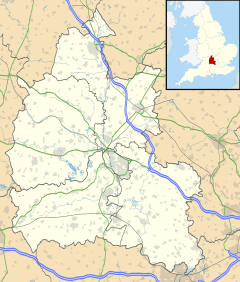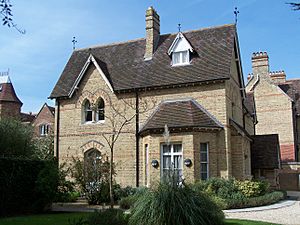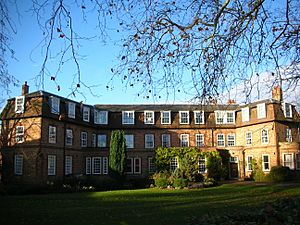North Oxford facts for kids
Quick facts for kids North Oxford |
|
|---|---|
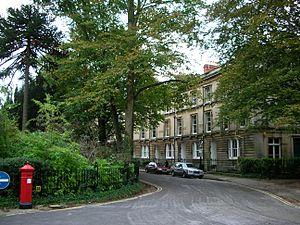 Park Town, one of central North Oxford's earliest Victorian suburban developments |
|
| OS grid reference | SP509079 |
| Civil parish |
|
| District | |
| Shire county | |
| Region | |
| Country | England |
| Sovereign state | United Kingdom |
| Post town | Oxford |
| Postcode district | OX2 |
| Dialling code | 01865 |
| Police | Thames Valley |
| Fire | Oxfordshire |
| Ambulance | South Central |
| EU Parliament | South East England |
| UK Parliament |
|
| Website | Oxford City Council |

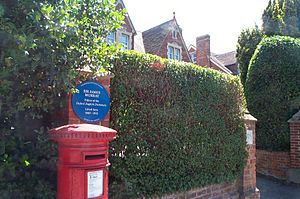
North Oxford is a cool suburban area in the city of Oxford, England. For many centuries, a big part of this land was owned by St John's College, Oxford. This college later sold many of the amazing Victorian houses in the area.
Contents
Discovering North Oxford's Main Areas
Two main roads, Woodstock Road and Banbury Road, run through North Oxford. They go from north to south and meet up at their southern ends to become St Giles. These roads lead to other towns like Woodstock and Banbury.
North Oxford is very well-known for its schools, especially its private ones.
Famous Schools in North Oxford
- Dragon School and Summer Fields are "preparatory schools." These are schools that prepare younger students for secondary school.
- St Edward's School, the Oxford High School for Girls, Wychwood School, and d'Overbroeck's College are all secondary schools.
- St. Clare's, Oxford is an international college for older students (sixth form). It's famous for offering the International Baccalaureate Diploma for a long time.
North Oxford's Geography and Landmarks
The exact borders of "North Oxford" can be a bit tricky to define. However, the original area built by St John's College is sometimes called "Central North Oxford." It stretches north from the top of St Giles' up to roads like Kingston Road and Marston Ferry Road. This area includes cool spots like Park Town.
Oxford University Colleges in North Oxford
North Oxford is home to several colleges that are part of Oxford University.
- Four former women's colleges are here: Lady Margaret Hall, St Anne's, St Hugh's, and Somerville.
- There are also four colleges for graduate students: Green Templeton College, St Antony's, Kellogg, and Wolfson.
Rivers and Green Spaces
The River Cherwell flows through the area. You can find the Cherwell Boathouse here, which is a popular place for punting (a type of boating). Further south, next to the Cherwell, are the beautiful University Parks. To the west, you'll find Port Meadow, a large open area of old common land next to the River Isis. The Isis is what the River Thames is called when it flows through Oxford.
Architecture and History
Much of central North Oxford has amazing examples of late 19th-century Victorian Gothic architecture. This means the buildings have a unique, old-fashioned style. It's now a special "conservation area," which helps protect its historic look.
Some buildings here are so important they are "Grade I listed." This includes the Church of St Philip and St James and the Radcliffe Observatory. The observatory is now part of Green Templeton College. You can also see Regency-style houses in Park Town. These were built in the mid-19th century when the area was still countryside.
Why People Love North Oxford
"Central North Oxford" is often called the most desirable suburb in Oxford. It's thought that it was first built for university "dons" (professors) once they were allowed to get married. However, many of the large houses were too expensive for most dons. Instead, successful business people from the city lived there. Today, many homes are owned by people who work in London and are drawn to the excellent schools. Some of the bigger houses are now used by Oxford colleges and other schools.
Northern Parts of North Oxford
At the very northern edge of North Oxford, near the A40 bypass, are three other suburbs: Sunnymead, Cutteslowe, and Wolvercote. Beyond the bypass is the village of Kidlington. The Wolvercote Cemetery is where the famous author J. R. R. Tolkien is buried. Cutteslowe Park is a big open park just north of the bypass.
Famous People from North Oxford
North Oxford has been home to many well-known people.
Authors and Academics
- J. R. R. Tolkien (1892–1973), the author of The Lord of the Rings, lived here.
- Iris Murdoch (1919–1999), another famous author and academic, also lived in North Oxford with her husband, John Bayley. Their life in the area was even shown in the movie Iris.
- T. E. Lawrence, known as Lawrence of Arabia, grew up on Polstead Road in North Oxford.
A Poet's View of North Oxford
Sir John Betjeman (1906–1984), who was a "Poet Laureate" (a special poet honored by the country), loved North Oxford. He wrote poems about the area, like May-Day Song for North Oxford:
Belbroughton Road is bonny, and pinkly bursts the spray
Of prunus and forsythia across the public way,
For a full spring-tide of blossom seethed and departed hence,
Leaving land-locked pools of jonquils by sunny garden fence.And a constant sound of flushing runneth from windows whence< The toothbrush too is airing in this new North Oxford air.


